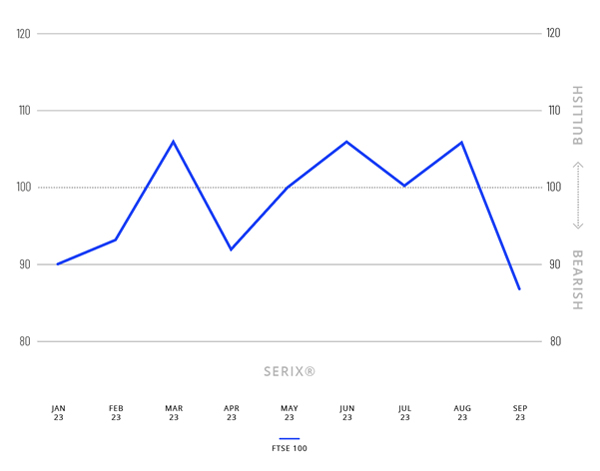- Spectrum's SERIX sentiment indicator for FTSE 100 dropped significantly to reach 87 points in September
- Challenging macroeconomic factors put downward pressure on equity market
- Volume of securitised derivatives traded reached 158 million for the month
Spectrum Markets (“Spectrum”), the pan-European trading venue for securitised derivatives, has published its SERIX sentiment data for European retail investors for September, revealing a steep decline in sentiment towards the FTSE 100 index, dropping to 87 points.
FTSE 100, the UK’s benchmark index, comprises the country’s 100 largest publicly traded companies. During September, this index saw a notable uptrend in the first half of the month, reaching its peak around September 20th before declining towards the month's end. The movement in the FTSE 100 price can be closely tracked to the sentiment of retail investors, as reflected in the SERIX.
The alignment of the two indices suggests that in September a significant proportion of activity on Spectrum linked to FTSE 100 was directional trading, though it’s likely there was still an element of hedging wider equities portfolio positions, which is also common.
The SERIX value indicates retail investor sentiment, with a number above 100 marking bullish sentiment, and a number below 100 indicating bearish sentiment. (See below for more information on the methodology).
Market opinion
“We’re seeing a complex combination of several negative, bottom-up factors simultaneously affecting the British economy. UK corporates have been affected by Brexit, Covid-19, an energy crisis, inflation, high national debt, high interest rates, and delayed effects from former Prime Minister Liz Truss’s ‘mini-budget’ policy. All these factors look to have eroded investor trust,” explains Michael Hall, Head of Distribution at Spectrum.
“Added to this, last month’s decision by the Bank of England to hold interest rates at 5.25 per cent reflects the current market uncertainty. And, it’s worth noting that four of the Bank’s nine Monetary Policy Committee members voted in favour of a further increase, so investors will be watching key economic data very closely in the coming weeks and months for a sign of what’s next.” Hall adds.
Spectrum’s September data
In September 2023, 158 million securitised derivatives were traded on Spectrum, with 31.6% of trades taking place outside of traditional hours (i.e., between 17:30 and 9:00 CET).
90.3% of the traded derivatives were on indices, 6.4% on currency pairs, 2.2% on commodities, 1% on equities and 0.1% on cryptocurrencies, with the top three traded underlying markets being DAX 40 (41.1%), NASDAQ 100 (20.4%), and S&P 500 (10.7%).
Looking at the SERIX data for the top three underlying markets, the DAX 40 and the NASDAQ 100 both remained at the neutral and bullish zone respectively at 100 and 103, and the S&P 500 increased from a neutral 99 to a bullish 108.

Calculating SERIX data
The Spectrum European Retail Investor Index (SERIX), uses the exchange’s pan-European trading data to shed light on investor sentiment towards current development in financial markets.
The index is calculated on a monthly basis by analysing retail investor trades placed and subtracting the proportion of bearish trades from the proportion of bullish trades, to give a single figure (rebased at 100) that indicates the strength and direction of sentiment:
SERIX = (% bullish trades - % bearish trades) + 100
Trades where long instruments are bought and trades where short instruments are sold are both considered bullish trades, while trades where long instruments are sold and trades where short instruments are bought are considered bearish trades. Trades that are matched by retail clients are disregarded. (For a detailed methodology and examples, please visit this link).



